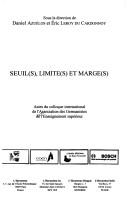| Listing 1 - 8 of 8 |
Sort by
|
Book
ISBN: 9782847430493 Year: 2013 Publisher: Paris Editions Pétra
Abstract | Keywords | Export | Availability | Bookmark
 Loading...
Loading...Choose an application
- Reference Manager
- EndNote
- RefWorks (Direct export to RefWorks)
Book
ISBN: 9782374960586 2374960587 2374961435 Year: 2018 Publisher: Reims Epure - Editions et presses universitaires de Reims
Abstract | Keywords | Export | Availability | Bookmark
 Loading...
Loading...Choose an application
- Reference Manager
- EndNote
- RefWorks (Direct export to RefWorks)
This volume, which focuses on the relations between the two branches of the Habsburg dynasty in the modern era, examines the ways in which identity was constructed exploring the idea of a joint policy of the House of Austria in Europe. It also examines, through various case studies, the movement through the Habsburg possessions of individuals who belonged not only to the elite but to a variety of social and professional circles - artists, ecclesiastics, merchants and scholars. Ce volume consacré aux relations entre les deux branches de la dynastie de Habsbourg à l’époque moderne s’intéresse aux modalités d’une construction identitaire et soumet à l’analyse l’idée d’une politique conjointe de la Maison d’Autriche en Europe, avant d’aborder, à travers quelques études de cas, la circulation à travers les possessions des Habsbourg d’individus appartenant non pas aux seules élites mais à des milieux sociaux et professionnels variés – artistes, ecclésiastiques, marchands et savants.
Relations culturelles --- Échange de savoirs --- Actes de congrès. --- Actes de congrès --- Habsbourg (dynastie) --- Habsbourg (famille de) --- Europe --- Habsburg [Dynasty] --- Royal houses --- History. --- Habsburg, House of --- Politics and government --- Kings and rulers --- Habsbourg (dynastie). --- History --- European history --- Early modern history: c 1450/1500 to c 1700 --- History of ideas --- Habsburg Monarchy --- Holy Roman Empire --- Culture exchanges
Book
ISBN: 9791024009452 Year: 2018 Publisher: Mont-Saint-Aignan Presses universitaires de Rouen et du Havre
Abstract | Keywords | Export | Availability | Bookmark
 Loading...
Loading...Choose an application
- Reference Manager
- EndNote
- RefWorks (Direct export to RefWorks)
Political conventions --- Congress of Vienna --- Europe --- Politics and government --- History of Germany and Austria --- anno 1800-1999 --- anno 2000-2009 --- Austria

ISBN: 2747506401 Year: 2001 Publisher: Paris : L'Harmattan,
Abstract | Keywords | Export | Availability | Bookmark
 Loading...
Loading...Choose an application
- Reference Manager
- EndNote
- RefWorks (Direct export to RefWorks)
Austrian literature --- Boundaries in literature --- German literature --- Germans --- Marginality, Social --- History and criticism
Book
ISBN: 3906754812 Year: 1997 Publisher: Bern [etc.] Peter Lang
Abstract | Keywords | Export | Availability | Bookmark
 Loading...
Loading...Choose an application
- Reference Manager
- EndNote
- RefWorks (Direct export to RefWorks)
Book
Year: 1992 Publisher: Asnières PIA
Abstract | Keywords | Export | Availability | Bookmark
 Loading...
Loading...Choose an application
- Reference Manager
- EndNote
- RefWorks (Direct export to RefWorks)
Book
ISBN: 9782841338450 Year: 2017 Publisher: Caen, France : ERLIS-Équipe de recherche sur les littératures, les imaginaires et les sociétés (EA 4254), Université de Caen Normandie,
Abstract | Keywords | Export | Availability | Bookmark
 Loading...
Loading...Choose an application
- Reference Manager
- EndNote
- RefWorks (Direct export to RefWorks)
Horses --- Horsemanship --- Horses in art --- Social aspects --- History --- Government policy --- Economic aspects
Book

ISBN: 2878547845 2878549392 Year: 2017 Publisher: Paris : Presses Sorbonne Nouvelle,
Abstract | Keywords | Export | Availability | Bookmark
 Loading...
Loading...Choose an application
- Reference Manager
- EndNote
- RefWorks (Direct export to RefWorks)
Manès Sperber (1905-1984) est l'un des grands témoins du vingtième siècle. Né dans un shtetl de Galicie orientale, mort à Paris, ce fils de rabbin quittera sa culture d'origine pour devenir un " hérétique fidèle " du judaïsme, de la psychologie adlérienne et surtout du communisme. Manès Sperber (1905 1984) is one of the great witnesses of the 20th century. Born in a shtetl of Oriental Galicia, deceased in Paris, this rabbi’s son will leave his original culture to become a «faithful heretic» of Judaism, of Adlerian psychology and especially of communism.
Literature German Dutch Scandinavian --- Manès Sperber --- judaïsme --- communisme
| Listing 1 - 8 of 8 |
Sort by
|

 Search
Search Feedback
Feedback About UniCat
About UniCat  Help
Help News
News